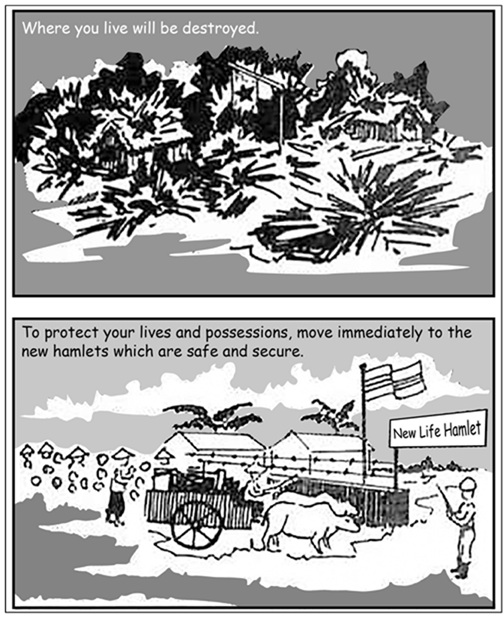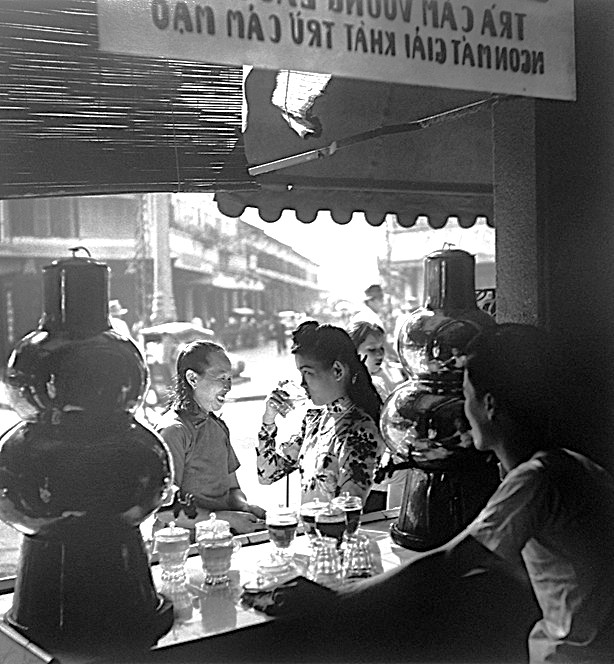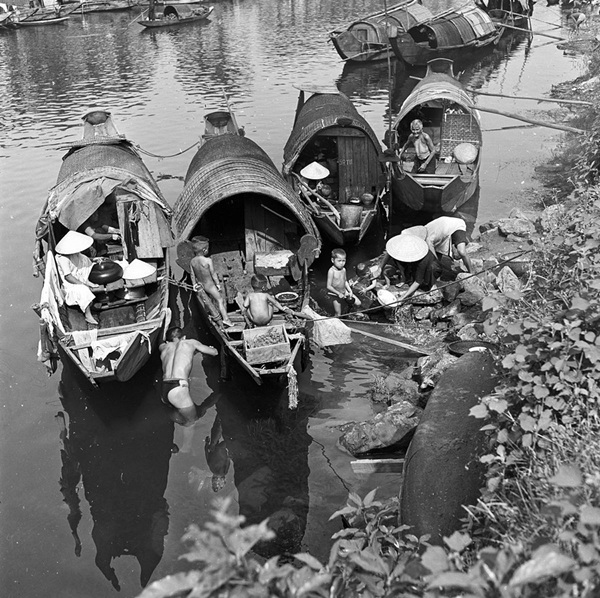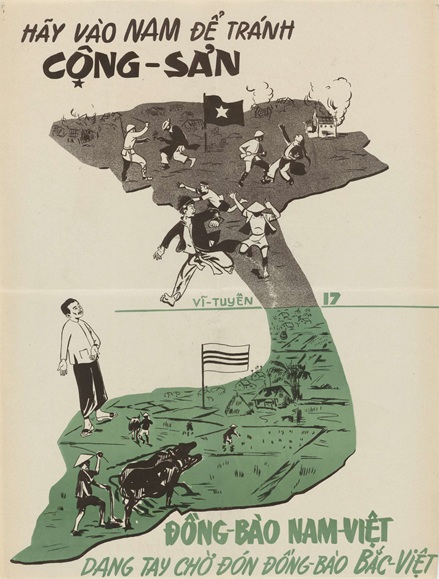|
|
|
Diem’s Government: Policies, Repression & CorruptionPolitical Structure and Leadership• Ngo Dinh Diem, a Catholic, led South Vietnam from 1955. • Diem’s government was authoritarian and nepotistic. He ruled with the help of his family, especially his brother Ngo Dinh Nhu (said to be an opium-addicted neo-Nazi) who controlled the South Vietnamese Army (ARVN) and ran private death squads and anti-Communist groups. • In 1954, Nhu established the Can Lao Party, limited to pro-Diem Catholics from the middle and upper classes. • Diem built a regime that served the rich landowners and pro-Catholic elites. Although Buddhists made up the majority of the population, he gave out government positions, land and money to Catholic supporters and Can Lao party members. • In the 1955 South Vietnam elections, Diem claimed 98% of the vote, including 605,000 votes in Saigon, which had only 450,000 registered voters. Under US pressure, this was adjusted to a more plausible 70%, indicating electoral fraud. • He ignored the Geneva agreement for all-Vietnam elections in 1956. Repressive Measures• Diem hunted down opponents of his regime – including communists, the Cao Dai and Hoa Hao religious sects and a private army called the Binh Xuyen – and ‘re-educated’ them in prison camps. In May 1959, he issued the notorious Law 10/59. This decree empowered military tribunals to execute or imprison anyone linked to Communist or left-wing groups. At least 12,000 people were executed for refusing to change their views. • Censorship was extreme.
• The US-funded Saigon Military Mission – a unit of about 1000 military advisers sent to Vietnam – trained the ARVN in guerrilla warfare. During Diem's presidency, American military involvement grew steadily:
|
Going DeeperThe following links will help you widen your knowledge: Basic accounts from BBC Bitesize and Clever Lili
YouTube Diem's Vietnam 1954-63 - Mr Cloke (fuller treatment) Strategic Hamlets - Mr Cloke
|
Economic Policies• Diem tried to develop South Vietnam’s economy with a 1957 Five Year plan. Foreign investment was encouraged through government guarantees, low taxes and rent concessions. US-backed subsidies supported domestic firms, while import tariffs protected local products. Factory and farm machinery, motor vehicles and raw materials such as steel and ore were imported. • Agricultural production improved. Rice output increased from 70,000 to 340,000 tons, 1955-60. • Most peasants remained landless. Diem did not carry out land reform – instead, he gave land to his rich Catholic landowner friends. Poor farmers were heavily taxed or forced to work for free. Strategic Hamlets Program• Initially called the ‘Agroville program’, this 1959 initiative aimed to isolate rural populations from Vietcong influence by relocating peasants into fortified villages (which were, in effect, concentration camps in all but name). In 1962 the US funded a huge expansion of the program, renaming the settlements 'Strategic Hamlets'. By 1963, two thirds of South Vietnam’s population had been moved – often at gunpoint. • The program faced problems:
• Despite the government’s claim that 8,600 hamlets had been established by 1963, only about 2,000 were completed. When US funding stopped, many were abandoned.
|
Source A
One of the thousands of American leaflets dropped by aircraft into villages in Vietnam in the 1960s.
|
People's LivesUrban vs. Rural Disparities• South Vietnamese society remained deeply unequal. A wealthy, urban, largely French-speaking elite of landowners and professionals lived in Saigon, enjoying fine French-style housing, luxury cars, concerts, nightclubs and cocktail parties. • This contrasted with – and scandalised – the traditional, simpler and much poorer lives of the rest of the population, 80% of whom lived in the countryside. • Floods and Vietcong activities between 1959-62 led to food shortages, particularly of rice, but also livestock, fruit and vegetables. Public Health and Social Infrastructure• Housing and factory conditions for the poor were appalling. Sanitation was poor, and clean drinking water scarce, despite a $17.5 million US loan for improvements. • Malaria was endemic, despite an eradication campaign begun in 1958 (the Viet Cong disrupted the spraying of marshes saying – correctly – that DDT would poison the environment), and many other diseases and parasites were common; with the death rate double that of the US Women's Rights and Roles• The 1959 Code of the Family, sponsored by Madame Nhu, Diem’s sister-in-law, granted women equal legal status in marriage, outlawed polygamy, and made divorce difficult. • Women were active in various sectors:
• Madame Nhu, sponsored strict moral laws passed in 1962 (banning boxing, cockfighting, sorcery, beauty contests, cabaret dancing, alcohol sales to children, and birth control) and claimed women’s equality, but used the Women’s Solidarity Movement to help the regime. Youth Engagement and Education• The Youth Movement Cong Hoa, with 1.3 million members, participated in road repair, hospital construction, agroville building and ‘security duties’. • Education expanded significantly:
• The government encouraged technical and educational content over the humanities and fiction, setting up 20 trades colleges to teach skills such as carpentry and ironworking. Work and Welfare• Article 14 of the 1956 Constitution guaranteed workers' rights, including the right to form trade unions. • The CVTC, a rice-farmer union with 500,000 members, was predominantly Buddhist; its leader Quoc Buu was also a Buddhist. • The 1952 Labour Code mandated employers to provide redundancy money and medical care for injuries at work, but lacked enforcement mechanisms. • After 1954, the government took over the administration of welfare, with some success, but there was no provision for unemployment or pensions. Refugee Crisis• Post-1954, in a USA-aided initiative named Operation Passage to Freedom, nearly one million refugees fled from North Vietnam to settle in the South. • 1954-63 an additional million people fled Vietcong-controlled or conflict-affected areas, meaning that one-eighth of the country's total population was composed of recently displaced persons … leading to social dislocation, overcrowding, worsened living conditions, and food shortages.
|
Source BThe members of the lowest level of urban society live in barges or boats or in crude dwellings. Most of the dwellings have neither electricity nor plumbing; their roofs and walls are of thatch, their floors of dirt. Such dwellings are built on land belonging to the government or to absentee landowners who do not have the power either to collect the rent or to evict the tenants without causing major political repercussions. The diet of the lower-class Vietnamese is strictly the traditional one, based mainly on rice and fish sauce. US Army Area Handbook for Vietnam (1964).
Source C
Photos of life in Saigon in the 1950s, taken by French photographer Raymond Cauchetier.
Source DThis US leaflet from 1954 urges "Come South to escape Communsm" and promises that the people of South Vietnam are "waiting with open arms". The North is shown as a dark place of desolation and violence, the South as green, peaceful and prosperous.
|
Growth of Opposition (1954–1963): the VietcongOrigins and Development• Diem’s corruption, repression and Catholic bias made him widely hated. Most South Vietnamese were Buddhist, but he allowed Catholic flags and celebrations, while banning Buddhist ones. This religious discrimination sparked protests. • Post-1954, the Viet Minh left 2,500 of their best and loyalist guerrilla fighters, along with caches of arms and ammunition in South Vietnam. By 1958, they numbered 9,000 By 1960, they were attacking in groups up to several battalions in strength. By 1962, they numbered 25,000. • Diem labelled his communist opponents the "Viet Cong" (short for ‘Vietnamese Communists’), a name meant to insult them. • In 1959, Ho Chi Minh ordered the commencement of a ‘people’s war’ in the South, leading communist fighters in the South to begin killing Diem’s officials (in the next two years, 8,000 were murdered). • In 1960, Ho Chi Minh set up the National Liberation Front (NLF). It did not just include communists – it was a patriotic movement to get rid of Diem, and to re-unite north and south Vietnam. Many middle class people (such as doctors and teachers) supported it, as well as the peasants and communists. • The Vietcong won the assistance of local peasants, who provided food and intelligence. Military Activities of the VietCong, 1959-63• Despite being outnumbered by ARVN forces (170,000 ARVN soldiers to 10,000 Vietcong in 1961), the Vietcong effectively used guerrilla tactics:
|
Source EWorking at their regular occupations during the day, they take part in night missions at the order of the guerrilla leader in their area. A typical village in an area where government control is weak may have 10, 15, or more of these activists. Their usual arms are knives and machetes, but a village group may have several submachineguns as well as rifles, grenades and landmines. US Army Area Handbook for Vietnam (1964).
Source FProbably, most villagers who cooperate with the Communists, however, do so out of fear of Viet Cong terror, although the Viet Cong also uses propaganda persuasion and enjoys the advantage of a membership which is itself largely peasant. It seems clear that the villager wants peace and security above all else and that, confronted with the competing armed authority of the government and of the Viet Cong, he will accept what he must and respond only slowly and cautiously to efforts to win his loyalty. US Army Area Handbook for Vietnam (1964).
Did You KnowThe Americans advising Diem became increasingly frustrated that he would not do as they advised. As one State Dept. official put it, Diem was ‘a puppet who pulled his own strings – and ours as well.’
|
The Fall of Diem
Source GCondemnation of Diem’s one-man-rule is becoming widespread in South Vietnam. A common complaint is that Diem surrounds himself with a small number of relatives and close friends. This has prevented effective government and promoted favouritism and dishonesty. Despite this growing pressure for reform, Diem will probably try and keep things as they are. But, in the long run, his stubbornness will only allow the Viet Cong to gain more support from the South Vietnamese people. From a report written by the US intelligence services for President Eisenhower in May 1960.
Buddhist Crisis• In May 1963, when Buddhists in Hue flew religious flags during Buddha's birthday celebrations, Government forces responded with violence, killing nine demonstrators, including children. • When 10,000 Buddhists went on a protest march about this, thousands of their leaders were arrested. Thich Quang Duc's Self-Immolation• On 11 June 1963, Buddhist monk Thich Quang Duc burned himself alive at a busy Saigon intersection, protesting religious persecution. • The event, captured in a photograph, shocked the international community. • Madame Nhu's dismissive comment: "If the Buddhists want another barbecue, I will be glad to give them the petrol and a match," further outraged public opinion. US Response and Coup• Diem relied heavily on the US for money, training and advisers. But as violence worsened and Diem refused to listen to American criticism, the US began to lose faith, leading President Kennedy to publicly criticize Diem on 2 September 1963. • The CIA, under Kennedy's directive, secretly supported a coup led by ARVN generals, including Duong Van Minh. • On 1 November 1963, the ARVN generals overthrew Diem’s government. At first, they planned to let him escape the country, but he and his brother fled. • Diem phoned the US embassy asking for help, but they refused to intervene. • On 2 November 1963, Diem and Nhu surrendered, but were assassinated in the back of an army vehicle.
|
Source HMr President, you must introduce greater democracy. The people demand freedom. You must guarantee their civil rights so everyone can express themselves without fear. You must allow opposition groups, critical of your government, to function freely. Only when all this is done can honest and fair government be restored. At the moment, power is in the hands of irresponsible members of your family. This makes good government impossible and promotes corruption. From a letter written to President Diem in April 1960.
Source IPresident Diem’s downfall was caused by his own mistakes. By 1963, his government was collapsing. The Strategic Hamlet Programme had caused great distress. Even members of Diem’s own government were outraged by his handling of the Buddhist protests. In the USA, President Kennedy did not believe that the Viet Cong could be defeated with Diem in power. The USA stopped its loans to South Vietnam and threatened to withdraw military aid. This finally encouraged the South Vietnamese generals to overthrow Diem. From Allan Pollock, Vietnam: Conflict and Change in Indochina (1995).
Source JDiem’s overthrow was ordered by President John F. Kennedy for domestic political reasons, in response to a propaganda campaign by the US media fed by the State Department. Diem and his brother Nhu were brutally assassinated by military thugs whom the US empowered to do this. All because Diem would not sacrifice his principles and Vietnamese sovereignty and accept America as its new colonial master. Review of Geoffrey Shaw, The American Betrayal of Diem by life coach Frank Medlar.
|
Consider:1. What can you learn from the photos in Source D about life in South Vietnam in the 1950s? 2. What do you make of Madame Nhu's social reforms? Interpretations: In his book
The American Betrayal of Ngo Dinh Diem (2015) military historian Geoffrey Shaw
argued: 3. Looking at all the evidence on this page, debate whether each of these claims has any merit. 4. Make a list of evidence which shows that the Americans were heavily involved in Vietnam during Diem's time as President of South Vietnam.
|
|
|
|
|
|
Spotted an error on this page? Broken link? Anything missing? Let me know. |
|



